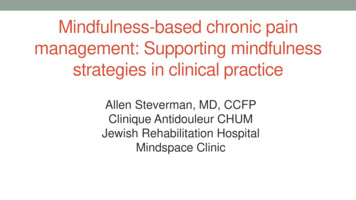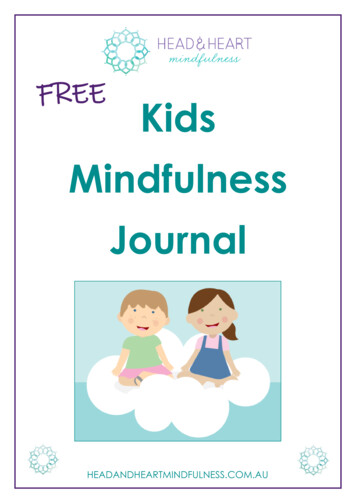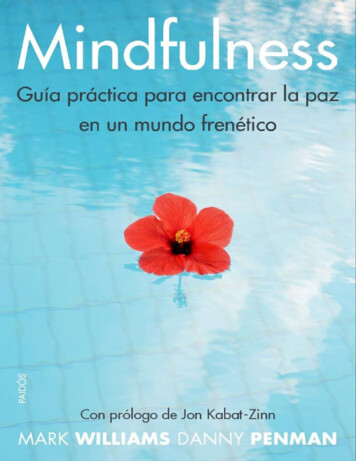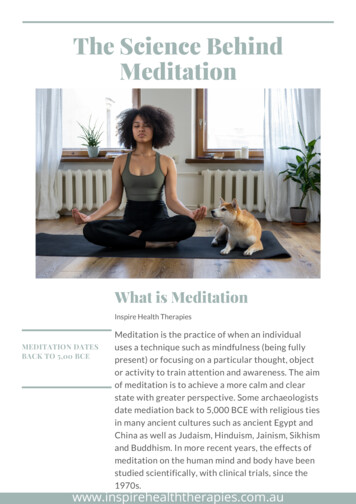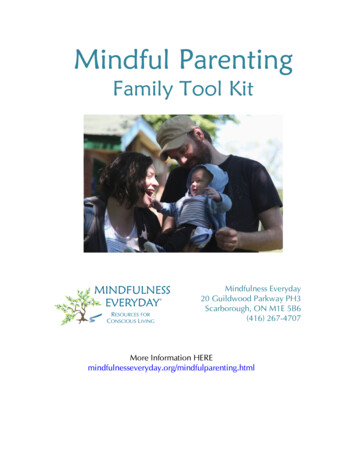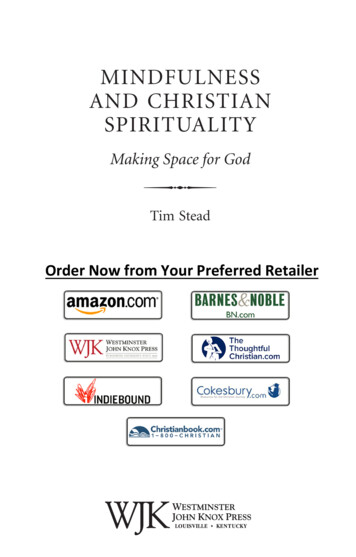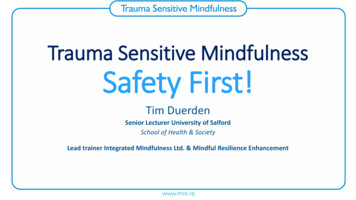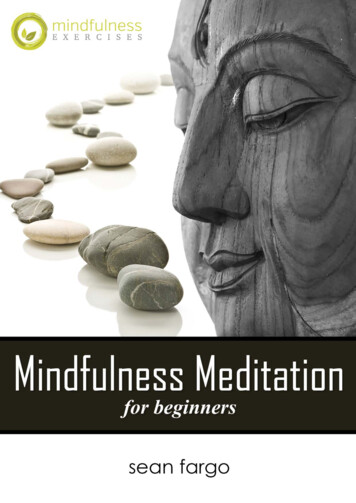
Transcription
Mindfulness Meditation for BeginnersPAGE i
Table of ContentsLiving Mindfully. 1Sitting Mindfully. 8Mindful Breathing. 8Mindful Sensations . 9Mindful Hearing. 9Mindful Thoughts and Emotions . 9Choiceless Awareness . 9Mindful Life Design . 17Part I - Inventory . 17Part II - Design . 19Cultivating Compassion . 21Your Mindfulness Journal. 22Mindfulness of Breathing . 23Journal for Mindful Breathing . 23Mindfulness of Walking . 24Sitting Meditation Instructions. 25Sitting Meditation Journal. 27For more mindfulness meditations, visit MindfulnessExercises.comMindfulness Meditation for BeginnersPAGE i
Living MindfullyFirst and foremost, I’d like to congratulate you on your decision to enhance your personal growththrough mindfulness. Try to keep in mind that this is something you are doing for yourself and yourwell-being, so it’s important for you to put in the effort and make a commitment to schedule formaltimes to practice these exercises just as you would other important appointments.Believe me, I know that sometimes it is easier said than done. It is not uncommon to lose enthusiasmand dedication to a new practice when obstacles arise and daily tasks begin to get in the way; as youcontinue on it’s important for you to figure out what is working and what’s not so that you can adjustyour practice, as needed.Before beginning mindfulness practices, it is imperative to understand the concept of mindfulness andwhat the practice of mindfulness can mean for you in your efforts towards personal growth.Mindfulness practice often embodies eight attitudes and it’s these attitudes below that contribute to thegrowth and flourishing of your mind, heart and body.1. Learner’s Mind – Seeing things as a visitor in a foreign land, everything is new and curious.2. Nonjudgmental – Becoming impartial, without any labels of right or wrong or good or bad.Simply allowing things to be.3. Acknowledgment – Recognizing things as they are.4. Settled – Being comfortable in the moment and content where you are.5. Composed – Being equanimous and in control with compassion and insight.6. Letting be – Letting things be as they are with no need to change them.7. Self-reliant – Deciding on your own, from your own experiences, what is true or not.8. Self-compassionate – Loving yourself as you are with no criticism or self-reproach.Take a moment to examine these attitudes in regard to your current state of mind. Write down theattitudes you wish to cultivate more of in your mindfulness practice.Mindfulness Meditation for BeginnersPAGE 1
Mindfulness Meditation for BeginnersPAGE 2
Keep in mind that once you begin to recognize the eight attitudes of mindfulness, it will become mucheasier for you to put these attitudes of mindfulness — learner’s mind, nonjudgmental,acknowledgment, settled, composed, letting be, self-reliant, and self-compassionate — into youractivities and with other people.Choose a task, such as baking a cake, and practice the attitudes of mindfulness during the task. Thisconcept might seem strange at first, but it really will help lead you on the path of mindfulness.See the example below: Begin the task with a learner’s mind, experience the texture of the ingredients as you gatherthem for preparing your cake. Whether you are baking from scratch or from a box, do so without any judgments aboutyourself, the cake or your cooking ability. Acknowledge the fact that you are self-reliant—that by baking this cake you are caring foryourself and others. Practice self-compassion by knowing that you are doing your best and do not get discouragedif the cake does not turn out the way you want it to. If your mind tries to rush ahead to the next baking step, settle down and realize that you are inthe present moment and bring your mind back to the task. Watch the cake while it bakes, as the batter rises and forms, and realize you are letting it be,letting the natural course take place and progress without any interference.Notice the difference in how your mind and body feel when these attitudes are present as opposed towhen they are not. Try to expand this practice into other areas of your daily life and see if it makes adifference in your relationships. Write down any changes you notice as you begin to practice theattitudes of mindfulness in your daily life.Mindfulness Meditation for BeginnersPAGE 3
As you begin to notice the difference in how your mind and body feel from practicing the eight attitudesof mindfulness, you will want to begin meditation exercises that help you learn to listen to your mindand body and become more in tune with what your mind and body needs.There are several body positions that work well for mindfulness practice and help you avoid sleepinessduring practice.Mindfulness Meditation for BeginnersPAGE 4
It is a personal preference whether you stand, sit or lie. If you stand, comfortable shoes willhelp you avoid the distraction of aching feet. If you sit, you may choose to sit on the floor, ona cushion or blanket or in a chair, or whatever is comfortable for you. If you choose to liedown it is important that you be fully awake to avoid becoming sleepy. It is also a personal preference whether you close your eyes or keep them open while youmeditate. If you are feeling tired, perhaps it would be best to keep them at least partiallyopened to avoid becoming sleepy. However, if you choose to meditate with your eyes open,remain focused on the meditation practice and avoid distractions. Assume a comfortable position to avoid your body becoming tense or rigid, thereby causingyou discomfort. This would be a distraction that could possibly keep you from meditation forvery long. On the other hand, you do not want to assume a position that is so comfortable thatyou end up falling asleep while meditation. If sleepiness is a problem for you during meditation, you may try meditation while standingor keeping your eyes open as mentioned above. Another option would be to take a nap priorto meditation so that you are well rested.During this next exercise, write down your thoughts about what body position you think will workbest for you during meditation exercises, making a checklist of things you may need prior tobeginning meditation exercises.For example, do you think you would prefer to stand, sit or lie? Do you have a position of comfort inmind to try during meditation? Do you have comfortable shoes if you meditate while standing? Doyou need a cushion or blanket if you sit in the floor to meditate? Will you keep your eyes open orclosed during meditation? Should you take a nap prior to meditating to avoid becoming sleepy duringmindful meditation?Mindfulness Meditation for BeginnersPAGE 5
Once you have decided on a body position that works for you for meditation exercises, you will alsowant to find a quiet place to meditate where you will be free from distractions and can concentratesolely upon yourself.The next meditation exercise we will discuss is called the mindful check-up. The mindful check-up isan excellent meditation exercise to begin with after familiarization with the eight attitudes ofmindfulness because as you begin to realize what your mind and body needs, you will need to developthe skills necessary to cater to these needs. The mindful check-up will promote listening to your mindMindfulness Meditation for BeginnersPAGE 6
and body and assist in centering and realigning yourself by helping you to realize how you are feelingemotionally, physically as well as mentally. This can be done throughout the day on a daily basis.Do this practice in a soothing environment with no distractions, such as a television or phone. It canbe done either sitting up or lying down, however, if you lie down and find yourself becoming sleepy,you should try a more upright position. Since the main focus point is the inner workings of your mindand body, you may want to try this with your eyes closed, however, if you prefer you may keep theopened partially. Concentrate solely on this practice for about three minutes. Begin this mindful check-up by delving into your mind and body and simply allowing anyemotion, thought or physical sensation to just be. Perhaps this is the first time you havestopped during your busy day to take a break. As you come to the state of being rather than doing, you may become aware of thoughts andfeelings you have carried throughout the day. These need no analyzation or judgment, onlyacknowledgement. Just allow yourself to be in the here and now, in the presence of themoment. Simply check in with yourself for about three minutes.When you have finished the exercise of mindful check-up for the first time, write down anysensations, feelings or thoughts that came to mind during the exercise.Mindfulness Meditation for BeginnersPAGE 7
As you begin to understand the inner workings of your mind and body through the mindful check-up,you will want to expand your meditation efforts to delve deeper into the mind and body connection.Sitting MindfullySitting mindfulness meditation begins with mindfulness of breathing then expands to physicalsensations, sounds, thoughts and emotions, and finally choiceless awareness. Expanding mindfulnesspractice with sitting meditation allows you to become more aware of your thoughts and feelings, alsobringing more awareness to habitual patterns of behavior that may not be in your best interest.Looking at your behavior with a beginner’s mind allows you to explore other possibilities and chose adifferent approach.Mindful BreathingThe first step of sitting meditation is usually mindfulness of breathing. The breath is in a constantstate of change as you inhale and exhale with breath coming in and going out, just like the ocean tides.Mindfulness Meditation for BeginnersPAGE 8
You must realize that everything in life changes and you can chose to go with the flow instead offighting it because the stronger the resistance, the greater the suffering.Mindful SensationsThe next step after mindful breathing is mindful sensations. Awareness of physical sensations isdifferent from the body scan. Instead of systemically checking the body part by part, you focus onsensations that are prevalent with each moment. Noticing sensations as they come and go throughoutthe body makes this exercise more insightful of the present moment experience. The body experiencesa myriad of sensations (pain, tingling, burning, warmth, coolness, itchiness, dryness and so on) thatmay be either pleasant, unpleasant, or neutral. If you don’t feel noticeable sensations, you can insteadfocus on points of contact, such as your back against the chair or your feet touching the floor —anywhere you feel contact. With mindfulness meditation, instead of analyzing the sensations, yousimply acknowledge them.Mindful HearingThe next step after mindful sensations is mindful hearing. Mindful hearing can be practiced almostanytime and anywhere because sounds are always coming and going in our environment. If a specificsound is continual and possibly even irritating, such as a loud music, crying babies, or car alarms,simply bring attention to the sound itself without analyzing it. On a more basic level, the mind simplyhears sound waves. Auditory phenomena are ubiquitous; you cannot escape them. Even if youisolated yourself in a soundproof room, you’d still hear internal sounds of your heartbeat, your pulse,or ringing in the ears. Whatever you hear in your environment, try not to judge the sounds as good orbad. Simply notice how sounds come and go as transient events.Mindful Thoughts and EmotionsThe next step after mindful hearing is mindful thoughts and emotions. Focus your attention to themind and the thought process itself. Thoughts and emotions are always changing, just like the breath,sensations and sounds. Rather than getting engrossed in the contents of the mind, just experience thethought process. As you become aware of the stories you spin and the snares you create, you canbegin to disengage from them.Choiceless AwarenessThe last step of this exercise is choiceless awareness, where the present moment becomes your focusgoal. Choiceless awareness is being mindful of whatever happens during each moment in theMindfulness Meditation for BeginnersPAGE 9
continual progression of present moments—whatever arises in the mind and body, whether a sensoryphenomenon or thoughts and emotions. On the surface you may be very still, while internally you arewatching an influx of physical and mental experience.Working together, your mind and body interact through constantly changing mental and physicalstimuli such as thoughts, emotions, physical sensations, sights, sounds, smells, and tastes. Withchoiceless awareness, observe what is presently forefront in the mind and body. If nothing isespecially dominant to draw your focus, remember you can always go back to the breath – orsensations, sounds, or thoughts and emotions to anchor yourself to the present moment.Now that you understand the steps involved in the process of sitting mindfulness meditation, find aquiet spot free from distractions and then sit in a comfortable position that will allow you to remainalert and then focus your concentration on this exercise. As you bring yourself into the present moment, check the mind and body for thingsyou have carried throughout the day – perhaps things that have been going onrecently or thoughts from the events of the day. Whatever the thoughts and feelings are, simply acknowledge them and allow them tobe, without any analysis or judgment. Bring awareness to your breathing. Just breathe naturally and normally, withouttrying to control it; being mindful of the breath rising and falling as you inhale andexhale. As you breathe in focus on breathing in, and then as you breathe out, focus onbreathing out. Simply concentrate on the breath, breathing in and breathing out. Now gently shift your focus from the breath and bring it to sensations in the body.Observe and acknowledge the myriad of sensations flowing through the body as theychange with each moment. If you find areas of tightness and tension with your body check try to allow them tosoften and relax. If you are not able to soften and relax, acknowledge the sensations and allow them toflow wherever they need to go and do whatever they need to do.Mindfulness Meditation for BeginnersPAGE 10
Now draw attention to hearing, observing all sounds without ambivalence. Break thesounds down to basic sound waves that can be heard with the body. Acknowledge themultitude of varying sounds, internal and external, moment to moment. Notice how the sounds change with each moment, whether internal or external, thesounds rise and fall. Hear them appear and disappear, just sounds. Now gently shut out the sounds in the mind and shift focus to emotions and thoughts.Observe the mind without judgment; simply acknowledge the myriad of mentalformations with each moment. Like lying in a field and watching the clouds moveand change shape as they float by, watch the mind in the same manner. Notice how thoughts rise and form in the mind then recede when another thoughttakes over. The mind is constantly thinking about this and that, functioning with amind of its own, analyzing, planning, remembering, comparing, etc. Experience howthese thoughts appear and disappear as just thoughts. Try to avoid the pitfalls of mind snares and negative habits as you observe andexperience your thoughts and emotions. Try to just observe and let them be, knowingthey will appear, disappear and recede in time. If you do get caught up in thoughtsand feelings, that is okay, this is simply a way of returning to the present moment.Once you realize you are lost in thought, in that very moment you are no longer lost.Simply refocus on mind observation with the clouds of thoughts and emotionsfloating on and on. If you become frustrated with wandering mind, perhaps a short time of mindfulbreathing would help you center yourself again. Once you are again centered, withdraw awareness from mental events and focus onthe present moment itself as your primary goal. Choiceless awareness invites you to become mindful of whatever arises with eachmoment, in the mind and body, whether a stream of emotions or thoughts, sensations,sounds or other sensory experiences. Just sit back and absorb the internal experienceas your body and mind combine and interact with constantly changing stimuli.Mindfulness Meditation for BeginnersPAGE 11
Simply observe what is prevalent in the mind and body and be present to it. If nothingpredominates and you are unfocused, go back to another object or focus on breathingto anchor yourself in the present moment. Sometimes there are thoughts andemotions or sensations and sounds but if nothing is occurring, you are alwaysbreathing and that can be your anchor in the sea of change in your body and mind. As you learn to give space to whatever is arising inside without judgment, you canbegin to go with the flow. Then instead of fighting it, you will begin to acknowledgeand understand that all things change. Even feelings of anger, sadness, pain, anxietyand confusion will diminish if you give these feelings space. Now withdraw focus from choiceless awareness and come back to the breath, feel theentire body rise up on inhalation and fall down on exhalation.When doing this exercise for the first time, take some time to write about whatever came up for youemotionally, physically and mentally.Mindfulness Meditation for BeginnersPAGE 12
Now that you have done your first sitting meditation exercise, revisit your body position journal pageand see if your “game plan” worked well for you or are there things you would like to do differentlyin the future. Write down what did and did not work well for you during your first meditationexercise and things you may wish to do differently in the future.Mindfulness Meditation for BeginnersPAGE 13
Remember, mindfulness practice is something you are doing for yourself and your well-being. It isimportant to maintain enthusiasm and dedication to a new practice when obstacles arise and dailytasks begin to get in the way so it is important to figure out what is working and what is not so thatyou can adjust your practice as needed.Write down any obstacles or tasks that interfered with your mindful meditation exercises. Writedown any suggestions to avoid the interference in the future so you can continue to practice theseexercises just as you would other important appointments.Mindfulness Meditation for BeginnersPAGE 14
Now that you have begun this new journey to enhance your personal growth and self-awarenessthrough mindfulness write down any differences you may have already noticed since beginning yourjourney.Mindfulness Meditation for BeginnersPAGE 15
For instance, what do you hope to accomplish through mindfulness practices? Do you see yourselfmaking lifestyle changes to incorporate mindfulness practices in your daily life and do you feel this issomething you will be able to commit to?The next section of this ebook will consist of a variety of mindfulness exercises.Mindfulness Meditation for BeginnersPAGE 16
Mindful Life Design“I think I have seen the Western mistake. You are very able to distinguish things, but you are unableto put all things together. If you continue in this way, you will never be able to repair this.”– Hsia Po-Yan, Chinese PhysicianThe intent in design is an elegant unity of form and function. Please follow this principle as youperform this exercise, and do not allow the linear nature of the work to distract you from viewing yourlife as a whole.Please address all the areas listed in the order listed and be open to what the questions evoke.Additionally, it’s important to keep integrating later work with earlier work so that your plan isintegrated, complete and realistic. Develop action plans, schedules, time-lines, lists of promises,requests, declarations, etc. as needed to design all areas of your life.Part I - InventoryA. LIFE NOW1. What is your life’s work?2. What is the public identity you currently have?3. Who are the people who are close to you?4. What are the domains of action in your life now?5. What are your current, unresolved breakdowns in all areas of your life?6. What is your basic, day-to-day mood?7. What specific resources do you have at your disposal? List money, cash flow, lines of credit,tools, expertise, vehicles, residences, education, access to information, insurance, licenses,certificates, clothes and all other useful equipment. Be exact in listing quality and quantityfor each item.8. What’s missing for you in your life?Mindfulness Meditation for BeginnersPAGE 17
9. What do you have too much of in your life?10. What conflicts do you experience (or see now) in your life? Review how you spend yourtime, allocate resources, attend to personal care, respond to the demands of work, and nurtureyour friends, family and lovers.11. What is working well for you in life?B. THE FUTURE1. What plans do you have (if any) for dealing with potential health problems, retirement, yourdeath, especially as you grow older?2. What is your career path?3. How do you keep yourself informed of trends and changes in the economy, local politics,national politics, technology, developments in your industry?4. What do you want to accomplish in your life? When do you see these accomplishmentshappening? What resources in addition to the ones you currently have will be necessary tofulfill these accomplishments?5. Do you plan to have a family? How large? When?6. How do you want to be known by others?7. What do you want to learn more about?8. Describe your life: 5 years from now 10 years from now 15 years from now 20 years from now 25 years from now.9. What is (are) the contribution(s) you want to be sure you make with your life? To whom?When?Mindfulness Meditation for BeginnersPAGE 18
10. What types of relationships do you want to have in the future?Part II - DesignA. GENERAL INSTRUCTIONSRead over everything you’ve written and begin to talk about the way you could live your life in orderto make the future you’ve described, given your life now. Beyond this, begin to talk about the styleyou want to bring to your activities, accomplishments and relationships.Start to write down the: Processes Procedures Routines Resources ToolsWhat is required to live your life in your style toward the future you describe? Be sure to includemaintenance of all your resources, and attending to your well-being.Mindfulness Meditation for BeginnersPAGE 19
Remember, the power of design is in the details and in the unity of the execution. Begin to bring yourwhole life to mind as you design the individual parts. Don’t compromise in your design, and berealistic.B. SPECIFIC DOMAINS1. What would your personal environment look like if it expressed your life design?Make a transition plan toward this state, if your environment is not already this way. Haveyour plan be consistent with your design.2. What would your personal presentation be like if it were consistent with your lifedesign? Include clothes, accessories, hairstyles, how your body looks, in your design.Again, make a transition plan if necessary.3. What relationships would you have if they were an integral part of your design?What specific people would be part of your life? In what ways? What types of peoplewould be in your life? In what ways?4. How would you allot your 168 hours each week in order to live your life as designed?Make a month’s plan in which you assign the 168 hours each week in a way that fulfills youand embodies your design. Make a transition plan for this if necessary (as in #1 above).5. Include in your design all of the other matters, concerns, interests and breakdownsthat this exercise evoked.Consolidate all your work into a master plan and a statement of how your life will look/feel when youfully implement your design. Include in your master plan what you may have to eliminate from yourlife, e.g., tools, clothes, merely distracting activities or destructive/non-contributing relationships.Mindfulness Meditation for BeginnersPAGE 20
Cultivating CompassionCompassion, my friends, is a major part of being mindful.Can you envision a state of mind where there is no harsh, condemning judgment of yourself or of others?This state of mind does not view the world in terms of good and evil or right and wrong; it sees only“suffering and no suffering.” What would happen if we did not judge any of the things that we see? Wewould see things that bring happiness and things that bring pain but we would not see fear, guilt orshame. Wouldn’t it be remarkable if we saw the world this way? When we only see suffering and nosuffering, we feel compassion.Compassion can lead to forceful action without judgment. For example, if we see a small child reachingfor a cup filled with hot coffee, we instantly respond. This response is born out of the compassion wefeel; we move to keep the child from harm, without any judgment.Compassion is the ability to feel someone else’s experiences and wish them to be free from pain. Toview life compassionately, we have to look beyond the end result of what is happening now, and lookat the underlying conditions that caused the end result. If you have insight into someone’s history youmay realize past events cause them to behave in a certain way. Then you can see the conditions thatled up to that situation, not just the end result of those conditions.For example, two people, a man and a woman, both suffered childhood abuse. The woman grew up tobe fearful; the man grew up to be angry. As adults they found themselves working together and thefearful woman disliked the angry man – until she gained some insight to his background and realizedhe had suffered the same as she had.This kind of understanding does not mean that we condone a person’s negative behavior but it doesmean that we can acknowledge the underlying factors that make up that person’s life opening us up tocompassion and forgiveness. Think of someone that you have had a problem with in the past. Can youlook beyond the problem and see that underlying conditions may have caused that person to reactnegatively – or perhaps underlying conditions caused you to react negatively. Can you view thesituation with compassion and forgiveness?Mindfulness Meditation for BeginnersPAGE 21
Your Mindfulness JournalWhen practicing mindfulness for the first time, write down anything that comes up emotionally,physically and mentally for you.Mindfulness Meditation for BeginnersPAGE 22
Mindfulness of Breathing Mindful breathing is best practiced with no distractions, such as a television or telephone, in atranquil environment. Mindful breathing can be practiced anytime during the day. It can bedone either sitting up or lying down, however, if you lie down and find yourself becomingsleepy, you should try a more upright position. Once you have gotten into position, breathe in and out naturally and examine of the act ofbreathing in and breathing out. Be aware of where the breath is most prominently coming from--- your chest, your nose, your stomach or somewhere else. Don’t distract yourself with counting the breaths or watching yourself breath, just visualize thebreath rising and falling like waves on the ocean, rising as you inhale and falling as you exhale.Focus on the here and now and concentrate on breathing. Do not manipulate your breathing in any way, just breathe normally and be aware of each breathas it comes and goes. If you notice your attention wandering from the breathing, just acknowledge the distraction andthen refocus back on breathing.Journal for Mindful BreathingWhen practicing this technique for the first time, write down anything that comes up emotionally,physically and mentally for you.Mindfulness Meditation for BeginnersPAGE 23
Mindfulness
Sitting mindfulness meditation begins with mindfulness of breathing then expands to physical sensations, sounds, thoughts and emotions, and finally choiceless awareness. Expanding mindfulness practice with sitting meditation allows you to become more aware of your thoughts and feelings, also
